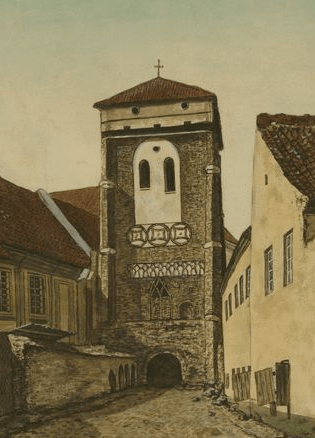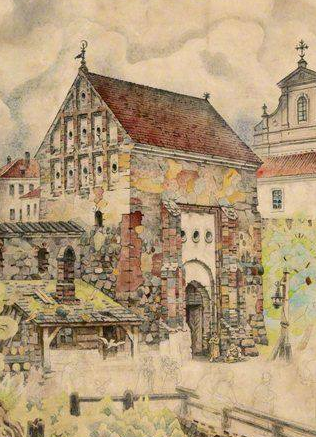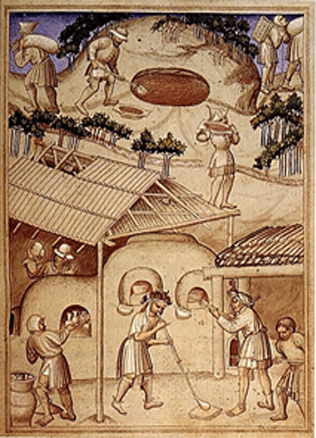The Image of Our Lady in the Church of Trakai: the Most Famous Miraculous Painting in the Grand Duchy of Lithuania
The parish church of the Visitation of the Most Blessed Virgin Mary in Trakai was built at the start of the 15th century by the Grand Duke of Lithuania Alexander Vytautas. At the start of the 17th century, after the painting of Our Lady, decorating the church, was proclaimed miraculous, the church of the Visitation of the Most Blessed Virgin Mary in Trakai became a famous centre across the entire Grand Duchy of Lithuania.
Echoes of the miraculous fame attributed to the painting
At the very start of the 17th century, religious festivities were held in the honour of the Blessed Virgin Mary. The site attracted numerous pilgrims. In 1603, when the plague was ravaging the country, the Bishop of Vilnius Benedict Wojna was the first to organize a penitential pilgrimage from Vilnius to Trakai, heading the huge procession bare-footed.
The help and intercession of Our Lady was requested during the times of major disasters and calamities, whereas the joyful historical events were also attributed to the mercy of Our Lady.
For example, after a significant victory against the Turks near Chotin (1621) a festive procession to Trakai, with the aim of paying tribute to the Blessed Virgin Mary, was held in 1622. Over time, it evolved into a regular tradition. The painting was also visited during the usual celebrations of Our Lady. Bishop Eustachy Wołłowicz in his notification to the Holy Seat in 1629 stated that the painting of the Trakai church attracted to the land of Mary crowds of sincerely devout people. Word of this miraculous place spread even further after Dean of Trakai church Simonas Mankevičius published a book, entitled History of the Parish Church on Trakai. In it, valuable data about the history of the church and the painting was provided and the grace attributed to the image was described. In 1650, the second part of the Miscellaneous Stories from the Lithuanian History was published in Vilnius by the Jesuit historian Albert Wijuk-Kojałowicz. In the publication, the Trakai church with the painting of Our Lady was assigned to the most famous places of the Grand Duchy of Lithuania, “famous for a special grace of miraculous power.” The author also highlighted the fact that namely the Jesuits were the first to encourage people to “more ceremoniously express their piety and devotion to God.: Together with the Congregation Mariana uniting the students of Vilnius Academy, the Jesuits launched the initiative of holding annual religious processions from Vilnius to Trakai (those processions were poetically depicted by Maciej Kazimierz Sarbiewski). At a later time, such processions, attended by pilgrims not only from the capital but also from Kaunas, Merkine and other towns, were held by other monastic orders.
Signs of gratitude expressed by the believers
In the 18th century, the image was fitted with silver casings, and votive offerings donated by the faithful, as expensive signs of vows or gratitude for the prayers answered and the grace received, were hung beside it. In the 17th century, Mary’s head was also adorned with a crown of gold. In 1718, Bishop of Vilnius Konstantin Kazimierz Brzostowski obtained permission from the Pope Clement XI (1700-21) to crown the miracle-working image, as established by the Chapter of the Vatican Basilica. The celebrations of the coronation rite which took place on Sept. 4, 1718, lasted for nine days. This was the first image to gain a papal crown in Lithuania after Our Lady of Częstochowa was crowned in 1717 Vatican Basilica. Such an extent of the ceremony signified an exceptional reverence to the image and recognition of its miraculous powers (the decription of the celebrations was immortalized in a special publication of 1719). It is no coincidence that ever since then, Our Lady of Trakai has been held the patroness (Mother Protectrix) of the Lithuanian state.
No other painting of Mary created throughout the whole existence of the Grand Duchy could ever be compared to the fame of Our Lady in Trakai.
Until the end of the 18th century this was the most famous image in the Grand Duchy. It was only in the 19th century that the cult of the Our Lady of Trakai became overshadowed by an ever-increasing expansion of piety and veneration, shown to Our Lady (The Holy Mother of God) of the Dawn Gates in Vilnius.
In the 17th-18th centuries, copies of the painting of Our Lady of Trakai were hung on the altars of various churches of the Grand Duchy. They were also held miraculous, and in some churches, storing such copies, independent centres of worshipping the image started to develop. The oldest and most famous copy is at Agluona in Latvia.
Between the legend and reality
Regardless of such immense popularity, the available historical evidence about the origin and early history of the picture Mary, known as Our Lady of Trakai, is fairly scarce. This is a typical case in history. The pictures which were venerated by the believers and held miraculous in the Grand Duchy were often surrounded with legends. In the course of history, the real facts of their origin would fade into oblivion.
Legend has it that the picture was donated in 1390 to Grand Duke Vytautas by the Byzantine Emperor Manuel II Palaeologus (1391–1425) on the occasion of his Baptism. This is testified by the still surviving inscription on the other side of the picture. However, the research conducted shows that it could not have been the current picture of Our Lady of Trakai. It is highly likely that Grand Duke Vytautas might have donated to his church in Trakai another picture, the fate of which is unknown? The current “iconic” look of the Our Lady of Trakai picture resembles the Byzantine style of painting and cannot possibly be authentic. Having conducted thorough research, the restorers have drawn the conclusion that the original picture must have been larger in size and that the Blessed Virgin Mary must have been portrayed in a different manner – full-length, standing, bare-headed, holding Baby Jesus in front of her. Judging by the style of painting, such an image could have been created at the junction of the 15th-16th centuries, as it is characterized by the features of Gothic painting.
During the major repair work of the interior of the Trakai church (around 1600), a new Great Altar was installed. The picture was made smaller in size (with its lower part cut off) and certain changes introduced in it. Thus, instead of a sheer veil, a hood (a cowl) covering Mary’s head and forehead was painted, adorned with a Greek cross (which was characteristic of painting icons); Baby Jesus is portrayed sitting on the left knee of the Mother of God and the gilded ornamental background has been changed as well. Thus, the visual “aging” of the image was performed at the start of the 17th century. Such changes could be interpreted as an attempt to make the picture look more in line with the narrative related to Vytautas’ name. However, despite the efforts to give a touch of Byzantine icon-specific features to the picture, it also acquired the details reflecting significant religious topicalities of the 17th century, e.g., a rose twig with three blossoms in Mary’s hands, symbolizing the three parts of the rosary (these details were absent in the primary image), is believed to be related to the Brotherhood of the Rosary, established around 1611 and functioning in the Trakai church.
Rūta Janonienė




